Qualification Graduate Diploma in Management: CRM Report
VerifiedAdded on 2021/03/01
|12
|3487
|272
Report
AI Summary
This report, prepared for a Qualification Graduate Diploma in Management, focuses on Customer Relationship Management (CRM). It begins with an introduction defining CRM and its importance, followed by an exploration of CRM types (Operational, Collaborative, and Analytical) and models (IDIC and CRM Value Chain). The report then delves into the benefits of CRM, such as improved customer service and retention, while also acknowledging its limitations. The impact of CRM on customer retention is discussed, emphasizing its role in building customer loyalty and increasing profitability. Finally, the report presents a case study of CRM implementation at United Airlines. The document is a comprehensive analysis of CRM strategies and their practical application in the business world.
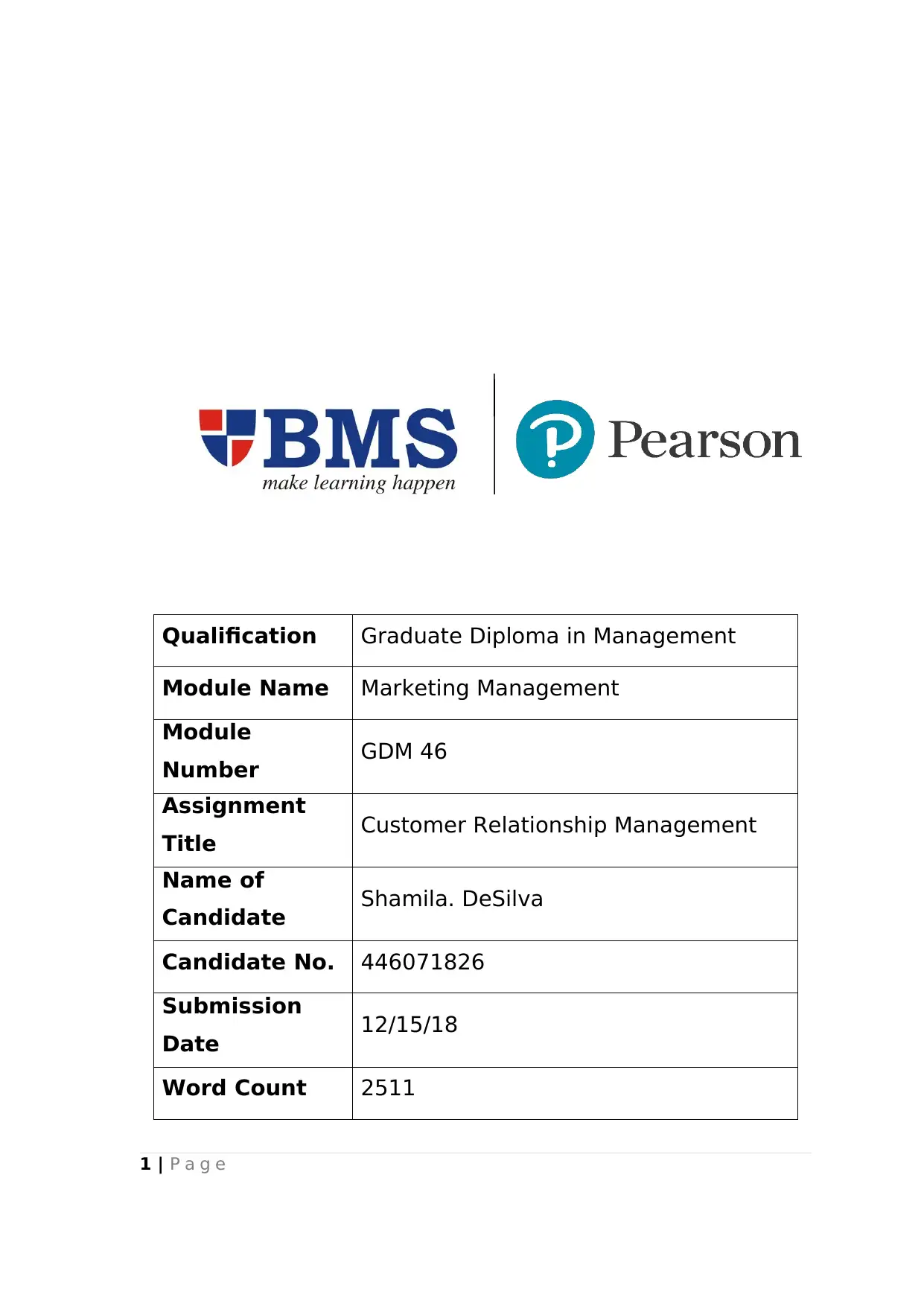
Qualification Graduate Diploma in Management
Module Name Marketing Management
Module
Number GDM 46
Assignment
Title Customer Relationship Management
Name of
Candidate Shamila. DeSilva
Candidate No. 446071826
Submission
Date 12/15/18
Word Count 2511
1 | P a g e
Module Name Marketing Management
Module
Number GDM 46
Assignment
Title Customer Relationship Management
Name of
Candidate Shamila. DeSilva
Candidate No. 446071826
Submission
Date 12/15/18
Word Count 2511
1 | P a g e
Paraphrase This Document
Need a fresh take? Get an instant paraphrase of this document with our AI Paraphraser
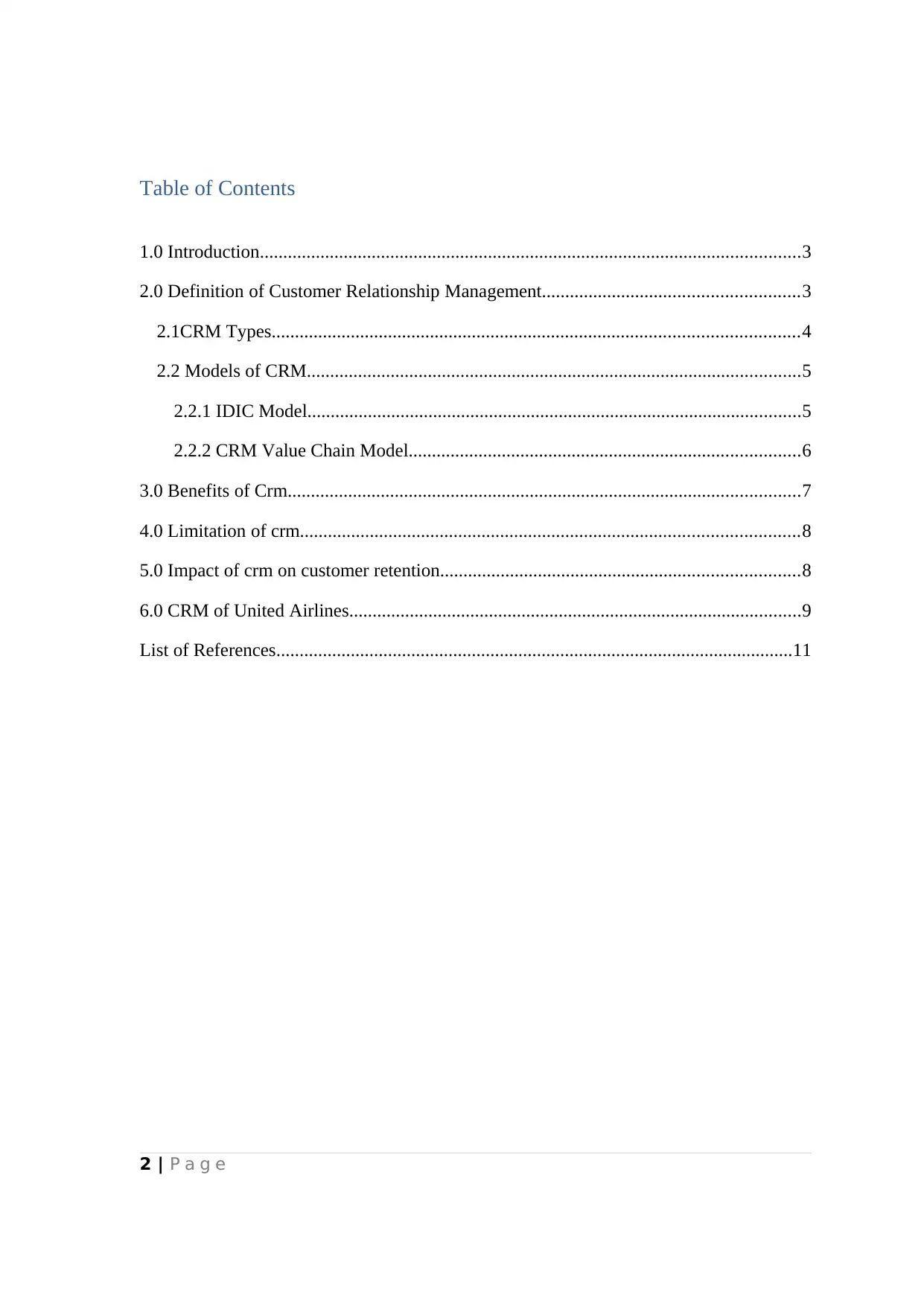
Table of Contents
1.0 Introduction....................................................................................................................3
2.0 Definition of Customer Relationship Management.......................................................3
2.1CRM Types.................................................................................................................4
2.2 Models of CRM..........................................................................................................5
2.2.1 IDIC Model..........................................................................................................5
2.2.2 CRM Value Chain Model....................................................................................6
3.0 Benefits of Crm..............................................................................................................7
4.0 Limitation of crm...........................................................................................................8
5.0 Impact of crm on customer retention.............................................................................8
6.0 CRM of United Airlines.................................................................................................9
List of References...............................................................................................................11
2 | P a g e
1.0 Introduction....................................................................................................................3
2.0 Definition of Customer Relationship Management.......................................................3
2.1CRM Types.................................................................................................................4
2.2 Models of CRM..........................................................................................................5
2.2.1 IDIC Model..........................................................................................................5
2.2.2 CRM Value Chain Model....................................................................................6
3.0 Benefits of Crm..............................................................................................................7
4.0 Limitation of crm...........................................................................................................8
5.0 Impact of crm on customer retention.............................................................................8
6.0 CRM of United Airlines.................................................................................................9
List of References...............................................................................................................11
2 | P a g e
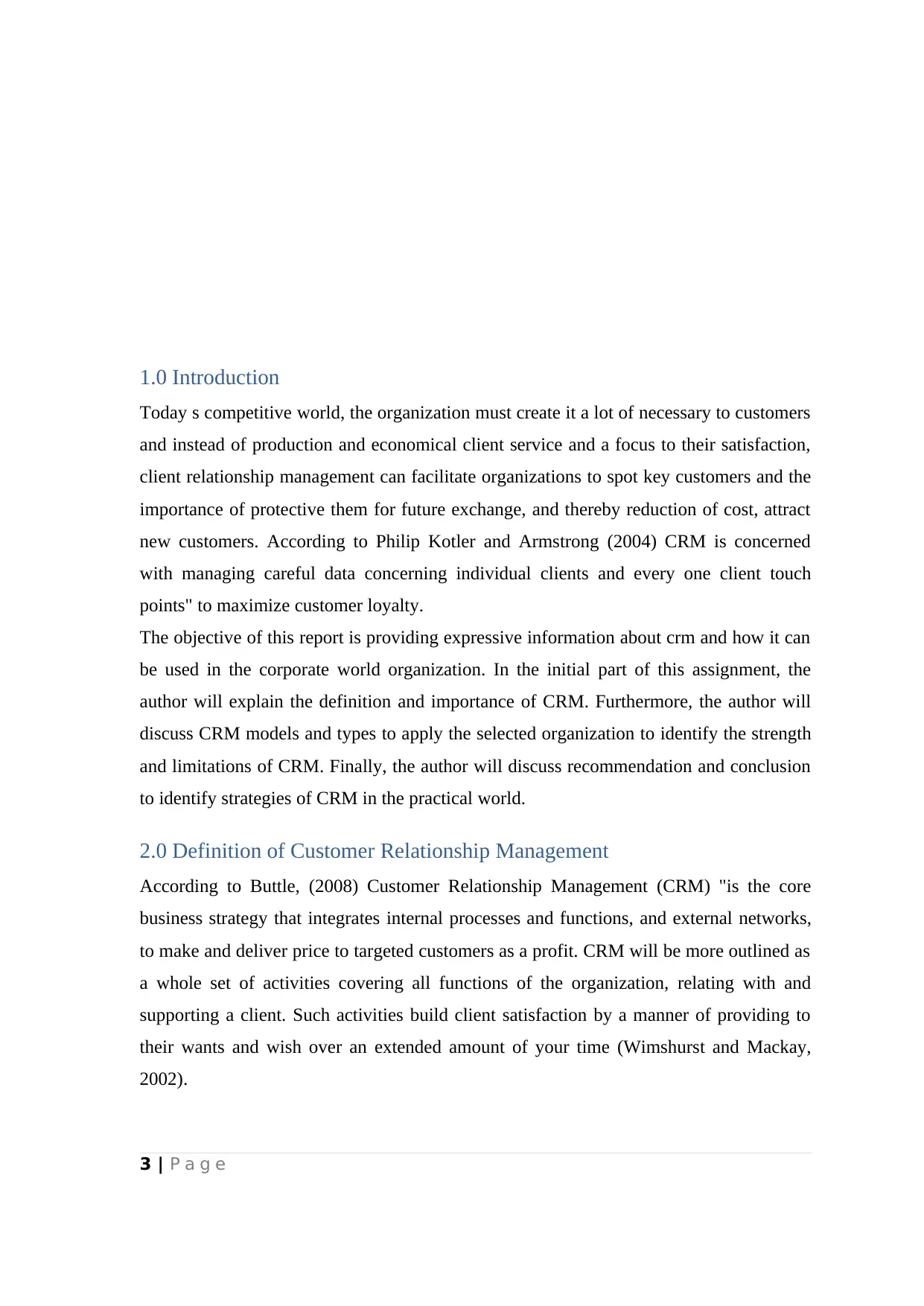
1.0 Introduction
Today s competitive world, the organization must create it a lot of necessary to customers
and instead of production and economical client service and a focus to their satisfaction,
client relationship management can facilitate organizations to spot key customers and the
importance of protective them for future exchange, and thereby reduction of cost, attract
new customers. According to Philip Kotler and Armstrong (2004) CRM is concerned
with managing careful data concerning individual clients and every one client touch
points" to maximize customer loyalty.
The objective of this report is providing expressive information about crm and how it can
be used in the corporate world organization. In the initial part of this assignment, the
author will explain the definition and importance of CRM. Furthermore, the author will
discuss CRM models and types to apply the selected organization to identify the strength
and limitations of CRM. Finally, the author will discuss recommendation and conclusion
to identify strategies of CRM in the practical world.
2.0 Definition of Customer Relationship Management
According to Buttle, (2008) Customer Relationship Management (CRM) "is the core
business strategy that integrates internal processes and functions, and external networks,
to make and deliver price to targeted customers as a profit. CRM will be more outlined as
a whole set of activities covering all functions of the organization, relating with and
supporting a client. Such activities build client satisfaction by a manner of providing to
their wants and wish over an extended amount of your time (Wimshurst and Mackay,
2002).
3 | P a g e
Today s competitive world, the organization must create it a lot of necessary to customers
and instead of production and economical client service and a focus to their satisfaction,
client relationship management can facilitate organizations to spot key customers and the
importance of protective them for future exchange, and thereby reduction of cost, attract
new customers. According to Philip Kotler and Armstrong (2004) CRM is concerned
with managing careful data concerning individual clients and every one client touch
points" to maximize customer loyalty.
The objective of this report is providing expressive information about crm and how it can
be used in the corporate world organization. In the initial part of this assignment, the
author will explain the definition and importance of CRM. Furthermore, the author will
discuss CRM models and types to apply the selected organization to identify the strength
and limitations of CRM. Finally, the author will discuss recommendation and conclusion
to identify strategies of CRM in the practical world.
2.0 Definition of Customer Relationship Management
According to Buttle, (2008) Customer Relationship Management (CRM) "is the core
business strategy that integrates internal processes and functions, and external networks,
to make and deliver price to targeted customers as a profit. CRM will be more outlined as
a whole set of activities covering all functions of the organization, relating with and
supporting a client. Such activities build client satisfaction by a manner of providing to
their wants and wish over an extended amount of your time (Wimshurst and Mackay,
2002).
3 | P a g e
⊘ This is a preview!⊘
Do you want full access?
Subscribe today to unlock all pages.

Trusted by 1+ million students worldwide
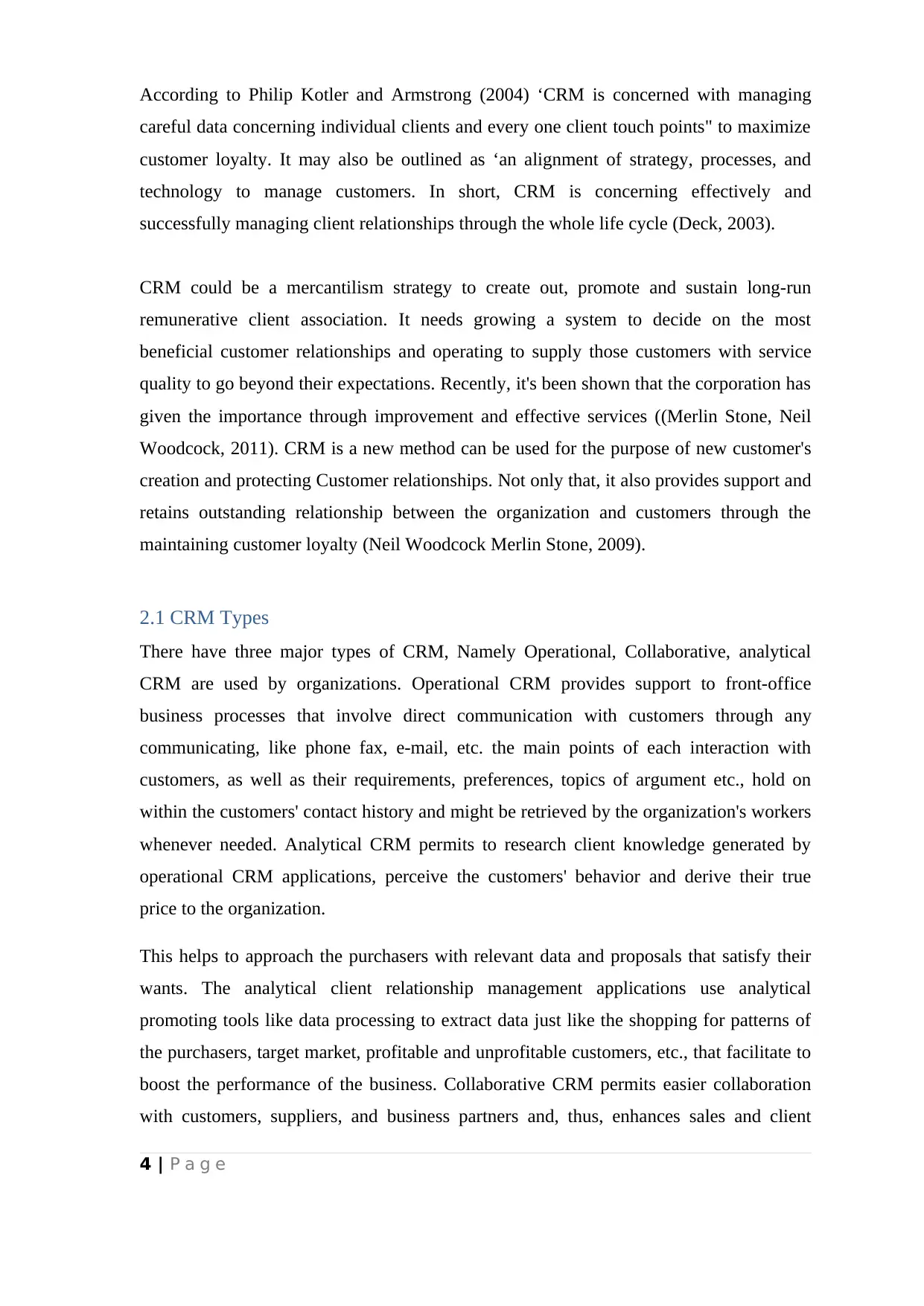
According to Philip Kotler and Armstrong (2004) ‘CRM is concerned with managing
careful data concerning individual clients and every one client touch points" to maximize
customer loyalty. It may also be outlined as ‘an alignment of strategy, processes, and
technology to manage customers. In short, CRM is concerning effectively and
successfully managing client relationships through the whole life cycle (Deck, 2003).
CRM could be a mercantilism strategy to create out, promote and sustain long-run
remunerative client association. It needs growing a system to decide on the most
beneficial customer relationships and operating to supply those customers with service
quality to go beyond their expectations. Recently, it's been shown that the corporation has
given the importance through improvement and effective services ((Merlin Stone, Neil
Woodcock, 2011). CRM is a new method can be used for the purpose of new customer's
creation and protecting Customer relationships. Not only that, it also provides support and
retains outstanding relationship between the organization and customers through the
maintaining customer loyalty (Neil Woodcock Merlin Stone, 2009).
2.1 CRM Types
There have three major types of CRM, Namely Operational, Collaborative, analytical
CRM are used by organizations. Operational CRM provides support to front-office
business processes that involve direct communication with customers through any
communicating, like phone fax, e-mail, etc. the main points of each interaction with
customers, as well as their requirements, preferences, topics of argument etc., hold on
within the customers' contact history and might be retrieved by the organization's workers
whenever needed. Analytical CRM permits to research client knowledge generated by
operational CRM applications, perceive the customers' behavior and derive their true
price to the organization.
This helps to approach the purchasers with relevant data and proposals that satisfy their
wants. The analytical client relationship management applications use analytical
promoting tools like data processing to extract data just like the shopping for patterns of
the purchasers, target market, profitable and unprofitable customers, etc., that facilitate to
boost the performance of the business. Collaborative CRM permits easier collaboration
with customers, suppliers, and business partners and, thus, enhances sales and client
4 | P a g e
careful data concerning individual clients and every one client touch points" to maximize
customer loyalty. It may also be outlined as ‘an alignment of strategy, processes, and
technology to manage customers. In short, CRM is concerning effectively and
successfully managing client relationships through the whole life cycle (Deck, 2003).
CRM could be a mercantilism strategy to create out, promote and sustain long-run
remunerative client association. It needs growing a system to decide on the most
beneficial customer relationships and operating to supply those customers with service
quality to go beyond their expectations. Recently, it's been shown that the corporation has
given the importance through improvement and effective services ((Merlin Stone, Neil
Woodcock, 2011). CRM is a new method can be used for the purpose of new customer's
creation and protecting Customer relationships. Not only that, it also provides support and
retains outstanding relationship between the organization and customers through the
maintaining customer loyalty (Neil Woodcock Merlin Stone, 2009).
2.1 CRM Types
There have three major types of CRM, Namely Operational, Collaborative, analytical
CRM are used by organizations. Operational CRM provides support to front-office
business processes that involve direct communication with customers through any
communicating, like phone fax, e-mail, etc. the main points of each interaction with
customers, as well as their requirements, preferences, topics of argument etc., hold on
within the customers' contact history and might be retrieved by the organization's workers
whenever needed. Analytical CRM permits to research client knowledge generated by
operational CRM applications, perceive the customers' behavior and derive their true
price to the organization.
This helps to approach the purchasers with relevant data and proposals that satisfy their
wants. The analytical client relationship management applications use analytical
promoting tools like data processing to extract data just like the shopping for patterns of
the purchasers, target market, profitable and unprofitable customers, etc., that facilitate to
boost the performance of the business. Collaborative CRM permits easier collaboration
with customers, suppliers, and business partners and, thus, enhances sales and client
4 | P a g e
Paraphrase This Document
Need a fresh take? Get an instant paraphrase of this document with our AI Paraphraser
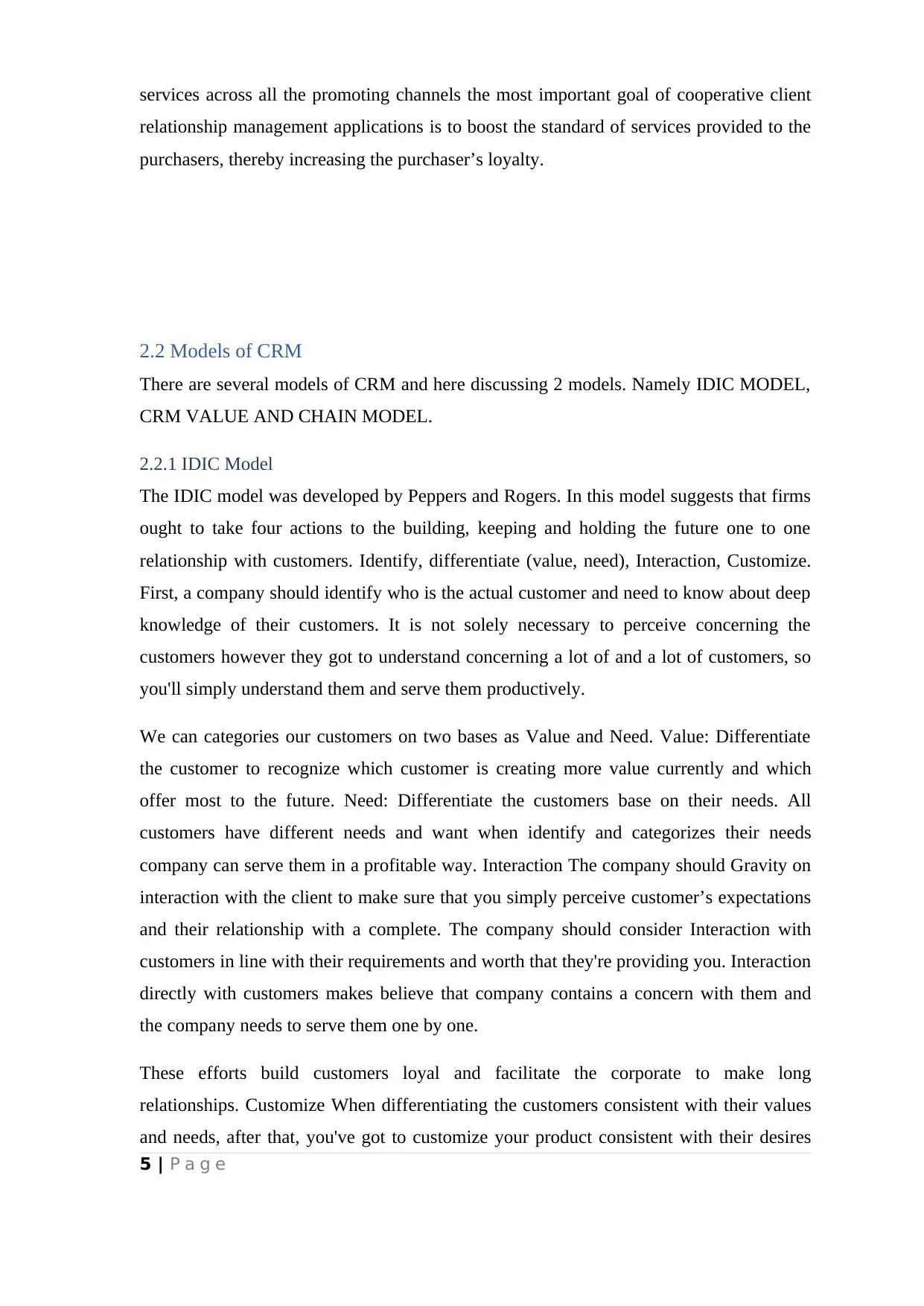
services across all the promoting channels the most important goal of cooperative client
relationship management applications is to boost the standard of services provided to the
purchasers, thereby increasing the purchaser’s loyalty.
2.2 Models of CRM
There are several models of CRM and here discussing 2 models. Namely IDIC MODEL,
CRM VALUE AND CHAIN MODEL.
2.2.1 IDIC Model
The IDIC model was developed by Peppers and Rogers. In this model suggests that firms
ought to take four actions to the building, keeping and holding the future one to one
relationship with customers. Identify, differentiate (value, need), Interaction, Customize.
First, a company should identify who is the actual customer and need to know about deep
knowledge of their customers. It is not solely necessary to perceive concerning the
customers however they got to understand concerning a lot of and a lot of customers, so
you'll simply understand them and serve them productively.
We can categories our customers on two bases as Value and Need. Value: Differentiate
the customer to recognize which customer is creating more value currently and which
offer most to the future. Need: Differentiate the customers base on their needs. All
customers have different needs and want when identify and categorizes their needs
company can serve them in a profitable way. Interaction The company should Gravity on
interaction with the client to make sure that you simply perceive customer’s expectations
and their relationship with a complete. The company should consider Interaction with
customers in line with their requirements and worth that they're providing you. Interaction
directly with customers makes believe that company contains a concern with them and
the company needs to serve them one by one.
These efforts build customers loyal and facilitate the corporate to make long
relationships. Customize When differentiating the customers consistent with their values
and needs, after that, you've got to customize your product consistent with their desires
5 | P a g e
relationship management applications is to boost the standard of services provided to the
purchasers, thereby increasing the purchaser’s loyalty.
2.2 Models of CRM
There are several models of CRM and here discussing 2 models. Namely IDIC MODEL,
CRM VALUE AND CHAIN MODEL.
2.2.1 IDIC Model
The IDIC model was developed by Peppers and Rogers. In this model suggests that firms
ought to take four actions to the building, keeping and holding the future one to one
relationship with customers. Identify, differentiate (value, need), Interaction, Customize.
First, a company should identify who is the actual customer and need to know about deep
knowledge of their customers. It is not solely necessary to perceive concerning the
customers however they got to understand concerning a lot of and a lot of customers, so
you'll simply understand them and serve them productively.
We can categories our customers on two bases as Value and Need. Value: Differentiate
the customer to recognize which customer is creating more value currently and which
offer most to the future. Need: Differentiate the customers base on their needs. All
customers have different needs and want when identify and categorizes their needs
company can serve them in a profitable way. Interaction The company should Gravity on
interaction with the client to make sure that you simply perceive customer’s expectations
and their relationship with a complete. The company should consider Interaction with
customers in line with their requirements and worth that they're providing you. Interaction
directly with customers makes believe that company contains a concern with them and
the company needs to serve them one by one.
These efforts build customers loyal and facilitate the corporate to make long
relationships. Customize When differentiating the customers consistent with their values
and needs, after that, you've got to customize your product consistent with their desires
5 | P a g e
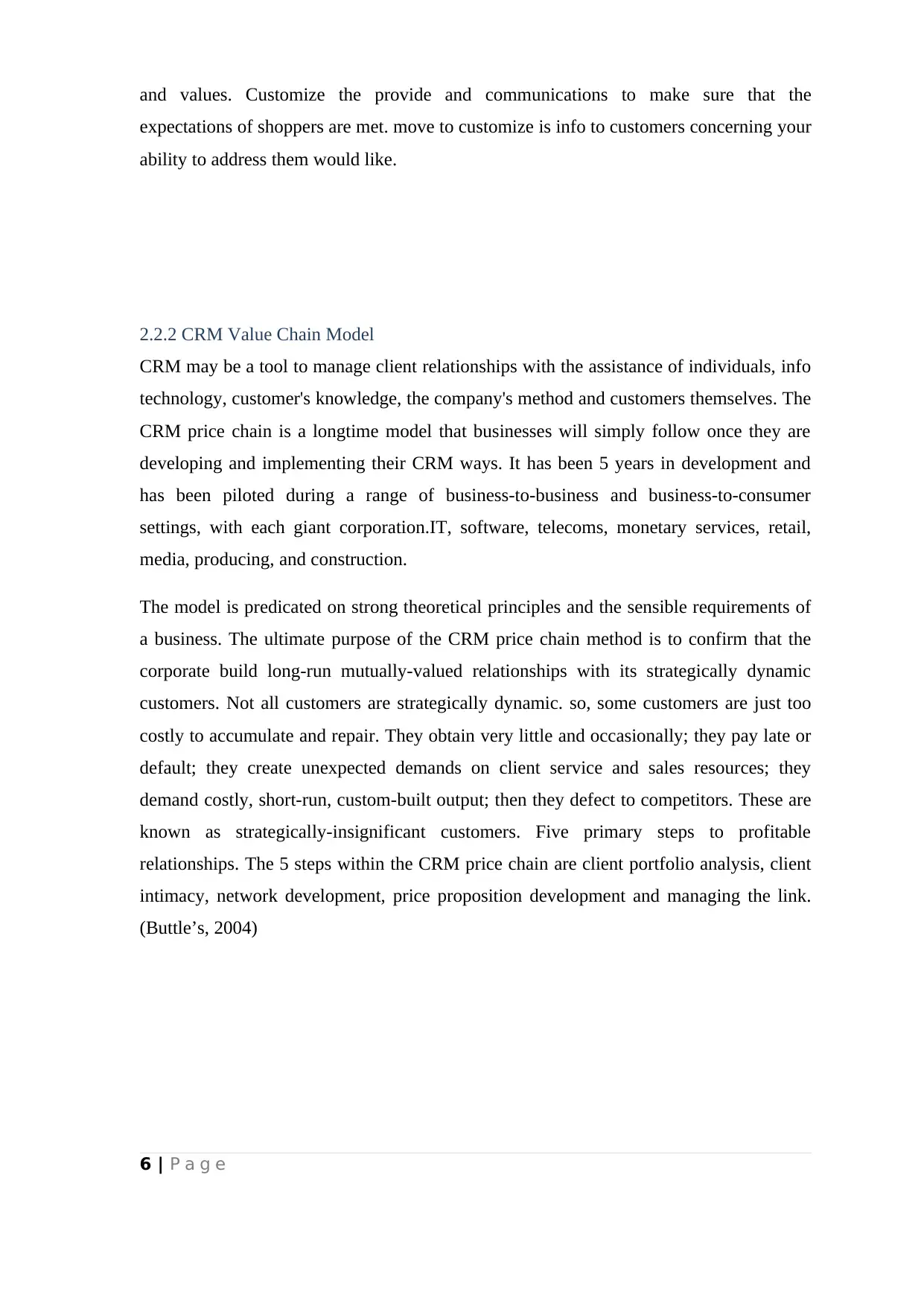
and values. Customize the provide and communications to make sure that the
expectations of shoppers are met. move to customize is info to customers concerning your
ability to address them would like.
2.2.2 CRM Value Chain Model
CRM may be a tool to manage client relationships with the assistance of individuals, info
technology, customer's knowledge, the company's method and customers themselves. The
CRM price chain is a longtime model that businesses will simply follow once they are
developing and implementing their CRM ways. It has been 5 years in development and
has been piloted during a range of business-to-business and business-to-consumer
settings, with each giant corporation.IT, software, telecoms, monetary services, retail,
media, producing, and construction.
The model is predicated on strong theoretical principles and the sensible requirements of
a business. The ultimate purpose of the CRM price chain method is to confirm that the
corporate build long-run mutually-valued relationships with its strategically dynamic
customers. Not all customers are strategically dynamic. so, some customers are just too
costly to accumulate and repair. They obtain very little and occasionally; they pay late or
default; they create unexpected demands on client service and sales resources; they
demand costly, short-run, custom-built output; then they defect to competitors. These are
known as strategically-insignificant customers. Five primary steps to profitable
relationships. The 5 steps within the CRM price chain are client portfolio analysis, client
intimacy, network development, price proposition development and managing the link.
(Buttle’s, 2004)
6 | P a g e
expectations of shoppers are met. move to customize is info to customers concerning your
ability to address them would like.
2.2.2 CRM Value Chain Model
CRM may be a tool to manage client relationships with the assistance of individuals, info
technology, customer's knowledge, the company's method and customers themselves. The
CRM price chain is a longtime model that businesses will simply follow once they are
developing and implementing their CRM ways. It has been 5 years in development and
has been piloted during a range of business-to-business and business-to-consumer
settings, with each giant corporation.IT, software, telecoms, monetary services, retail,
media, producing, and construction.
The model is predicated on strong theoretical principles and the sensible requirements of
a business. The ultimate purpose of the CRM price chain method is to confirm that the
corporate build long-run mutually-valued relationships with its strategically dynamic
customers. Not all customers are strategically dynamic. so, some customers are just too
costly to accumulate and repair. They obtain very little and occasionally; they pay late or
default; they create unexpected demands on client service and sales resources; they
demand costly, short-run, custom-built output; then they defect to competitors. These are
known as strategically-insignificant customers. Five primary steps to profitable
relationships. The 5 steps within the CRM price chain are client portfolio analysis, client
intimacy, network development, price proposition development and managing the link.
(Buttle’s, 2004)
6 | P a g e
⊘ This is a preview!⊘
Do you want full access?
Subscribe today to unlock all pages.

Trusted by 1+ million students worldwide
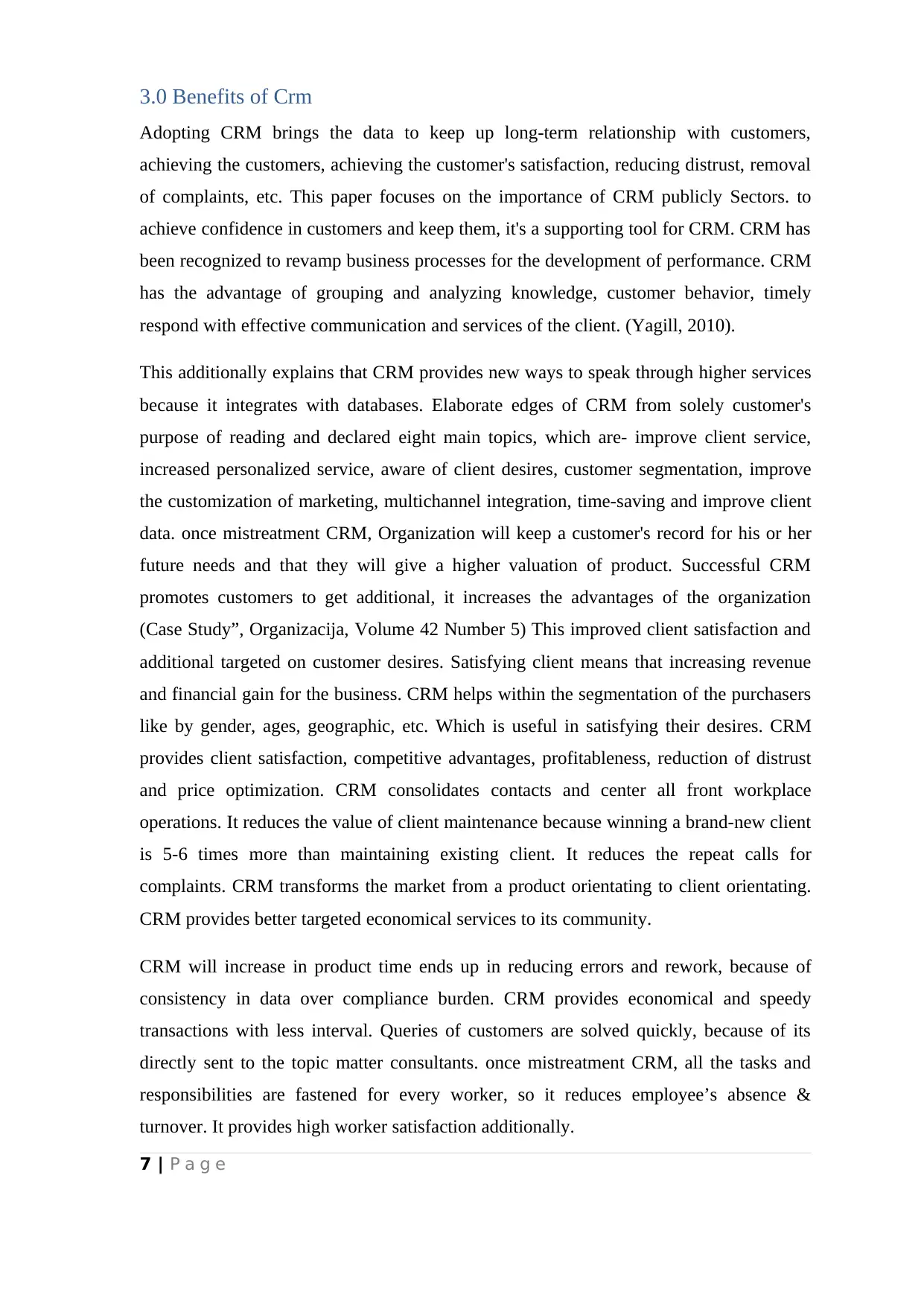
3.0 Benefits of Crm
Adopting CRM brings the data to keep up long-term relationship with customers,
achieving the customers, achieving the customer's satisfaction, reducing distrust, removal
of complaints, etc. This paper focuses on the importance of CRM publicly Sectors. to
achieve confidence in customers and keep them, it's a supporting tool for CRM. CRM has
been recognized to revamp business processes for the development of performance. CRM
has the advantage of grouping and analyzing knowledge, customer behavior, timely
respond with effective communication and services of the client. (Yagill, 2010).
This additionally explains that CRM provides new ways to speak through higher services
because it integrates with databases. Elaborate edges of CRM from solely customer's
purpose of reading and declared eight main topics, which are- improve client service,
increased personalized service, aware of client desires, customer segmentation, improve
the customization of marketing, multichannel integration, time-saving and improve client
data. once mistreatment CRM, Organization will keep a customer's record for his or her
future needs and that they will give a higher valuation of product. Successful CRM
promotes customers to get additional, it increases the advantages of the organization
(Case Study”, Organizacija, Volume 42 Number 5) This improved client satisfaction and
additional targeted on customer desires. Satisfying client means that increasing revenue
and financial gain for the business. CRM helps within the segmentation of the purchasers
like by gender, ages, geographic, etc. Which is useful in satisfying their desires. CRM
provides client satisfaction, competitive advantages, profitableness, reduction of distrust
and price optimization. CRM consolidates contacts and center all front workplace
operations. It reduces the value of client maintenance because winning a brand-new client
is 5-6 times more than maintaining existing client. It reduces the repeat calls for
complaints. CRM transforms the market from a product orientating to client orientating.
CRM provides better targeted economical services to its community.
CRM will increase in product time ends up in reducing errors and rework, because of
consistency in data over compliance burden. CRM provides economical and speedy
transactions with less interval. Queries of customers are solved quickly, because of its
directly sent to the topic matter consultants. once mistreatment CRM, all the tasks and
responsibilities are fastened for every worker, so it reduces employee’s absence &
turnover. It provides high worker satisfaction additionally.
7 | P a g e
Adopting CRM brings the data to keep up long-term relationship with customers,
achieving the customers, achieving the customer's satisfaction, reducing distrust, removal
of complaints, etc. This paper focuses on the importance of CRM publicly Sectors. to
achieve confidence in customers and keep them, it's a supporting tool for CRM. CRM has
been recognized to revamp business processes for the development of performance. CRM
has the advantage of grouping and analyzing knowledge, customer behavior, timely
respond with effective communication and services of the client. (Yagill, 2010).
This additionally explains that CRM provides new ways to speak through higher services
because it integrates with databases. Elaborate edges of CRM from solely customer's
purpose of reading and declared eight main topics, which are- improve client service,
increased personalized service, aware of client desires, customer segmentation, improve
the customization of marketing, multichannel integration, time-saving and improve client
data. once mistreatment CRM, Organization will keep a customer's record for his or her
future needs and that they will give a higher valuation of product. Successful CRM
promotes customers to get additional, it increases the advantages of the organization
(Case Study”, Organizacija, Volume 42 Number 5) This improved client satisfaction and
additional targeted on customer desires. Satisfying client means that increasing revenue
and financial gain for the business. CRM helps within the segmentation of the purchasers
like by gender, ages, geographic, etc. Which is useful in satisfying their desires. CRM
provides client satisfaction, competitive advantages, profitableness, reduction of distrust
and price optimization. CRM consolidates contacts and center all front workplace
operations. It reduces the value of client maintenance because winning a brand-new client
is 5-6 times more than maintaining existing client. It reduces the repeat calls for
complaints. CRM transforms the market from a product orientating to client orientating.
CRM provides better targeted economical services to its community.
CRM will increase in product time ends up in reducing errors and rework, because of
consistency in data over compliance burden. CRM provides economical and speedy
transactions with less interval. Queries of customers are solved quickly, because of its
directly sent to the topic matter consultants. once mistreatment CRM, all the tasks and
responsibilities are fastened for every worker, so it reduces employee’s absence &
turnover. It provides high worker satisfaction additionally.
7 | P a g e
Paraphrase This Document
Need a fresh take? Get an instant paraphrase of this document with our AI Paraphraser
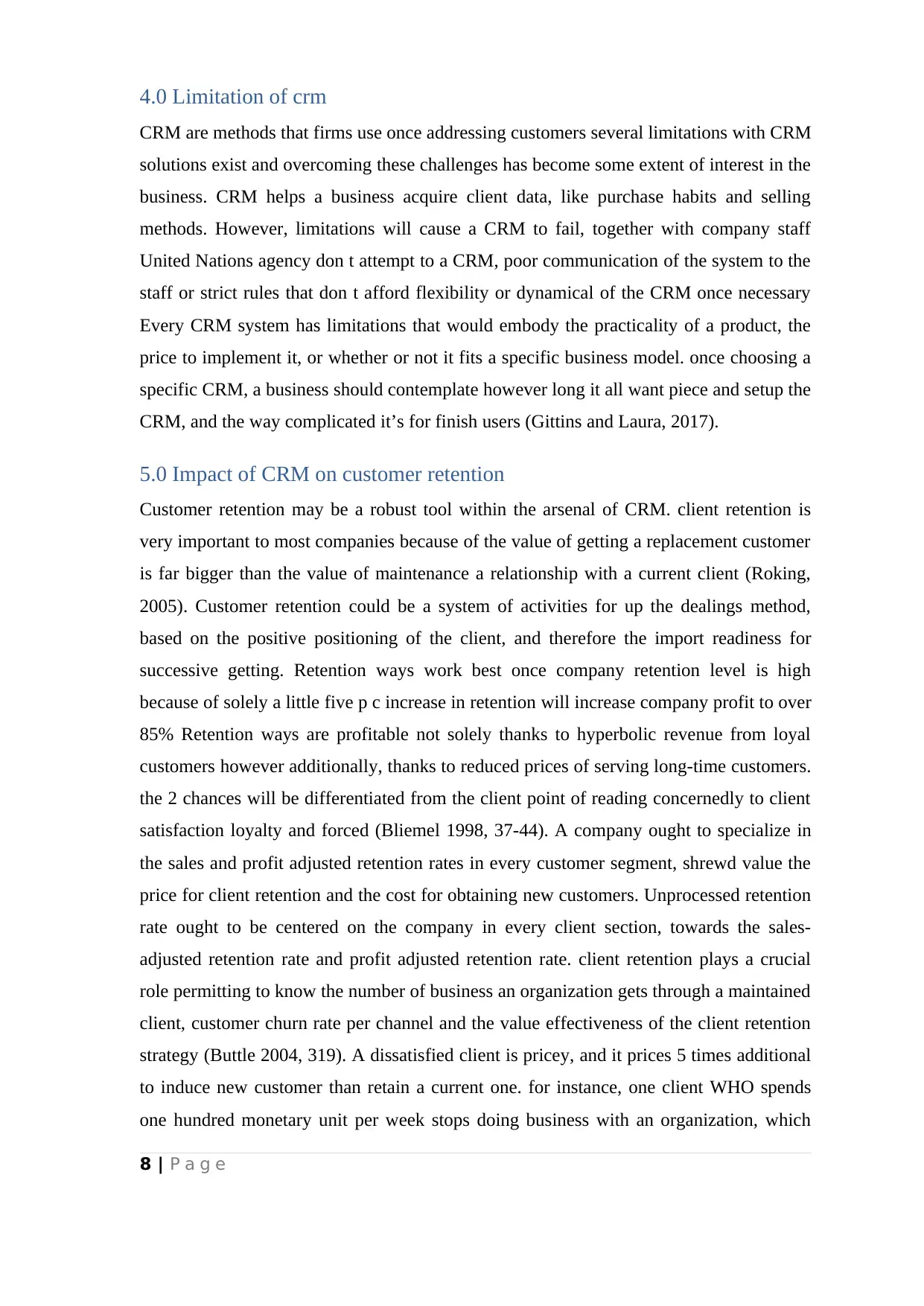
4.0 Limitation of crm
CRM are methods that firms use once addressing customers several limitations with CRM
solutions exist and overcoming these challenges has become some extent of interest in the
business. CRM helps a business acquire client data, like purchase habits and selling
methods. However, limitations will cause a CRM to fail, together with company staff
United Nations agency don t attempt to a CRM, poor communication of the system to the
staff or strict rules that don t afford flexibility or dynamical of the CRM once necessary
Every CRM system has limitations that would embody the practicality of a product, the
price to implement it, or whether or not it fits a specific business model. once choosing a
specific CRM, a business should contemplate however long it all want piece and setup the
CRM, and the way complicated it’s for finish users (Gittins and Laura, 2017).
5.0 Impact of CRM on customer retention
Customer retention may be a robust tool within the arsenal of CRM. client retention is
very important to most companies because of the value of getting a replacement customer
is far bigger than the value of maintenance a relationship with a current client (Roking,
2005). Customer retention could be a system of activities for up the dealings method,
based on the positive positioning of the client, and therefore the import readiness for
successive getting. Retention ways work best once company retention level is high
because of solely a little five p c increase in retention will increase company profit to over
85% Retention ways are profitable not solely thanks to hyperbolic revenue from loyal
customers however additionally, thanks to reduced prices of serving long-time customers.
the 2 chances will be differentiated from the client point of reading concernedly to client
satisfaction loyalty and forced (Bliemel 1998, 37-44). A company ought to specialize in
the sales and profit adjusted retention rates in every customer segment, shrewd value the
price for client retention and the cost for obtaining new customers. Unprocessed retention
rate ought to be centered on the company in every client section, towards the sales-
adjusted retention rate and profit adjusted retention rate. client retention plays a crucial
role permitting to know the number of business an organization gets through a maintained
client, customer churn rate per channel and the value effectiveness of the client retention
strategy (Buttle 2004, 319). A dissatisfied client is pricey, and it prices 5 times additional
to induce new customer than retain a current one. for instance, one client WHO spends
one hundred monetary unit per week stops doing business with an organization, which
8 | P a g e
CRM are methods that firms use once addressing customers several limitations with CRM
solutions exist and overcoming these challenges has become some extent of interest in the
business. CRM helps a business acquire client data, like purchase habits and selling
methods. However, limitations will cause a CRM to fail, together with company staff
United Nations agency don t attempt to a CRM, poor communication of the system to the
staff or strict rules that don t afford flexibility or dynamical of the CRM once necessary
Every CRM system has limitations that would embody the practicality of a product, the
price to implement it, or whether or not it fits a specific business model. once choosing a
specific CRM, a business should contemplate however long it all want piece and setup the
CRM, and the way complicated it’s for finish users (Gittins and Laura, 2017).
5.0 Impact of CRM on customer retention
Customer retention may be a robust tool within the arsenal of CRM. client retention is
very important to most companies because of the value of getting a replacement customer
is far bigger than the value of maintenance a relationship with a current client (Roking,
2005). Customer retention could be a system of activities for up the dealings method,
based on the positive positioning of the client, and therefore the import readiness for
successive getting. Retention ways work best once company retention level is high
because of solely a little five p c increase in retention will increase company profit to over
85% Retention ways are profitable not solely thanks to hyperbolic revenue from loyal
customers however additionally, thanks to reduced prices of serving long-time customers.
the 2 chances will be differentiated from the client point of reading concernedly to client
satisfaction loyalty and forced (Bliemel 1998, 37-44). A company ought to specialize in
the sales and profit adjusted retention rates in every customer segment, shrewd value the
price for client retention and the cost for obtaining new customers. Unprocessed retention
rate ought to be centered on the company in every client section, towards the sales-
adjusted retention rate and profit adjusted retention rate. client retention plays a crucial
role permitting to know the number of business an organization gets through a maintained
client, customer churn rate per channel and the value effectiveness of the client retention
strategy (Buttle 2004, 319). A dissatisfied client is pricey, and it prices 5 times additional
to induce new customer than retain a current one. for instance, one client WHO spends
one hundred monetary unit per week stops doing business with an organization, which
8 | P a g e
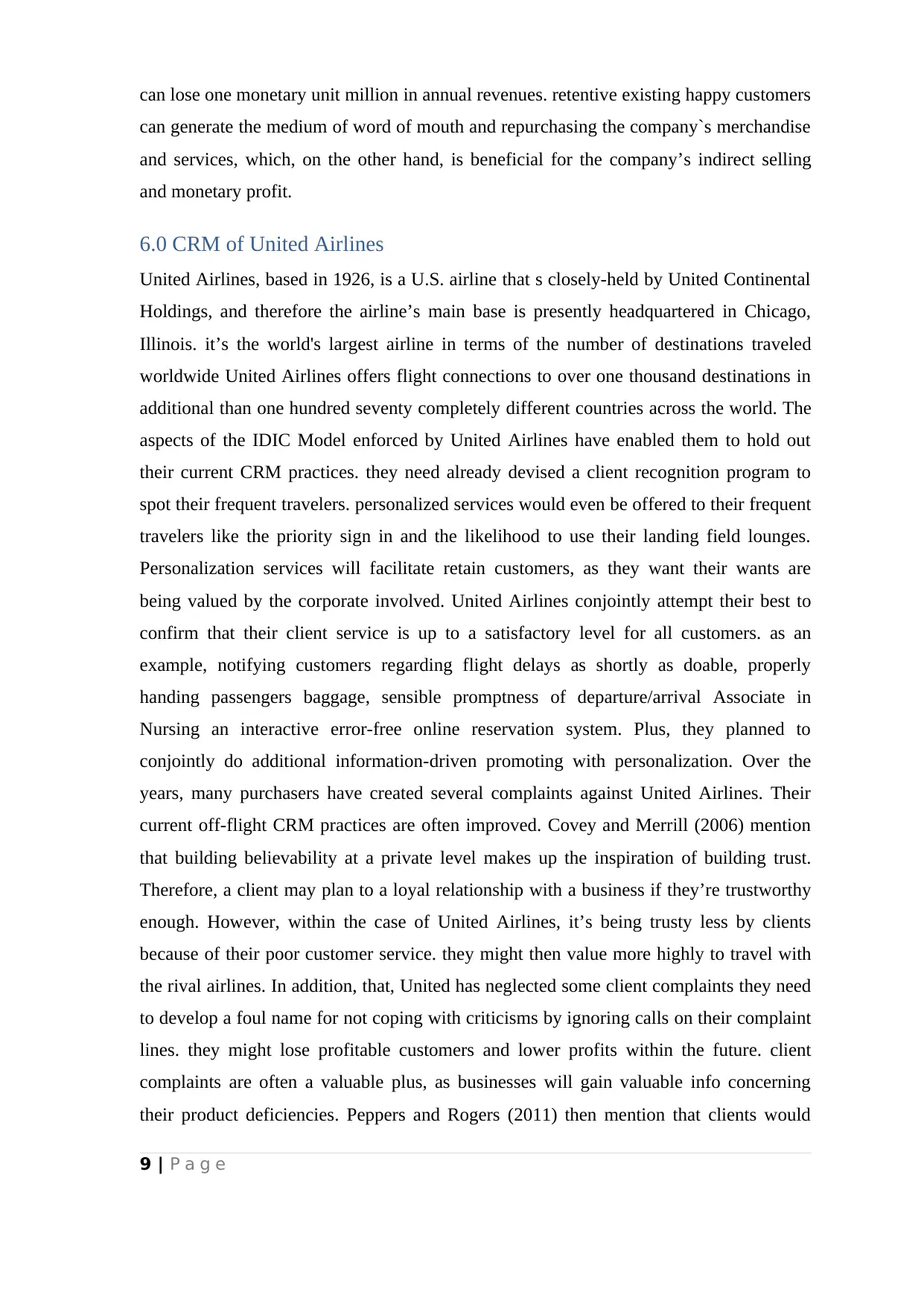
can lose one monetary unit million in annual revenues. retentive existing happy customers
can generate the medium of word of mouth and repurchasing the company`s merchandise
and services, which, on the other hand, is beneficial for the company’s indirect selling
and monetary profit.
6.0 CRM of United Airlines
United Airlines, based in 1926, is a U.S. airline that s closely-held by United Continental
Holdings, and therefore the airline’s main base is presently headquartered in Chicago,
Illinois. it’s the world's largest airline in terms of the number of destinations traveled
worldwide United Airlines offers flight connections to over one thousand destinations in
additional than one hundred seventy completely different countries across the world. The
aspects of the IDIC Model enforced by United Airlines have enabled them to hold out
their current CRM practices. they need already devised a client recognition program to
spot their frequent travelers. personalized services would even be offered to their frequent
travelers like the priority sign in and the likelihood to use their landing field lounges.
Personalization services will facilitate retain customers, as they want their wants are
being valued by the corporate involved. United Airlines conjointly attempt their best to
confirm that their client service is up to a satisfactory level for all customers. as an
example, notifying customers regarding flight delays as shortly as doable, properly
handing passengers baggage, sensible promptness of departure/arrival Associate in
Nursing an interactive error-free online reservation system. Plus, they planned to
conjointly do additional information-driven promoting with personalization. Over the
years, many purchasers have created several complaints against United Airlines. Their
current off-flight CRM practices are often improved. Covey and Merrill (2006) mention
that building believability at a private level makes up the inspiration of building trust.
Therefore, a client may plan to a loyal relationship with a business if they’re trustworthy
enough. However, within the case of United Airlines, it’s being trusty less by clients
because of their poor customer service. they might then value more highly to travel with
the rival airlines. In addition, that, United has neglected some client complaints they need
to develop a foul name for not coping with criticisms by ignoring calls on their complaint
lines. they might lose profitable customers and lower profits within the future. client
complaints are often a valuable plus, as businesses will gain valuable info concerning
their product deficiencies. Peppers and Rogers (2011) then mention that clients would
9 | P a g e
can generate the medium of word of mouth and repurchasing the company`s merchandise
and services, which, on the other hand, is beneficial for the company’s indirect selling
and monetary profit.
6.0 CRM of United Airlines
United Airlines, based in 1926, is a U.S. airline that s closely-held by United Continental
Holdings, and therefore the airline’s main base is presently headquartered in Chicago,
Illinois. it’s the world's largest airline in terms of the number of destinations traveled
worldwide United Airlines offers flight connections to over one thousand destinations in
additional than one hundred seventy completely different countries across the world. The
aspects of the IDIC Model enforced by United Airlines have enabled them to hold out
their current CRM practices. they need already devised a client recognition program to
spot their frequent travelers. personalized services would even be offered to their frequent
travelers like the priority sign in and the likelihood to use their landing field lounges.
Personalization services will facilitate retain customers, as they want their wants are
being valued by the corporate involved. United Airlines conjointly attempt their best to
confirm that their client service is up to a satisfactory level for all customers. as an
example, notifying customers regarding flight delays as shortly as doable, properly
handing passengers baggage, sensible promptness of departure/arrival Associate in
Nursing an interactive error-free online reservation system. Plus, they planned to
conjointly do additional information-driven promoting with personalization. Over the
years, many purchasers have created several complaints against United Airlines. Their
current off-flight CRM practices are often improved. Covey and Merrill (2006) mention
that building believability at a private level makes up the inspiration of building trust.
Therefore, a client may plan to a loyal relationship with a business if they’re trustworthy
enough. However, within the case of United Airlines, it’s being trusty less by clients
because of their poor customer service. they might then value more highly to travel with
the rival airlines. In addition, that, United has neglected some client complaints they need
to develop a foul name for not coping with criticisms by ignoring calls on their complaint
lines. they might lose profitable customers and lower profits within the future. client
complaints are often a valuable plus, as businesses will gain valuable info concerning
their product deficiencies. Peppers and Rogers (2011) then mention that clients would
9 | P a g e
⊘ This is a preview!⊘
Do you want full access?
Subscribe today to unlock all pages.

Trusted by 1+ million students worldwide
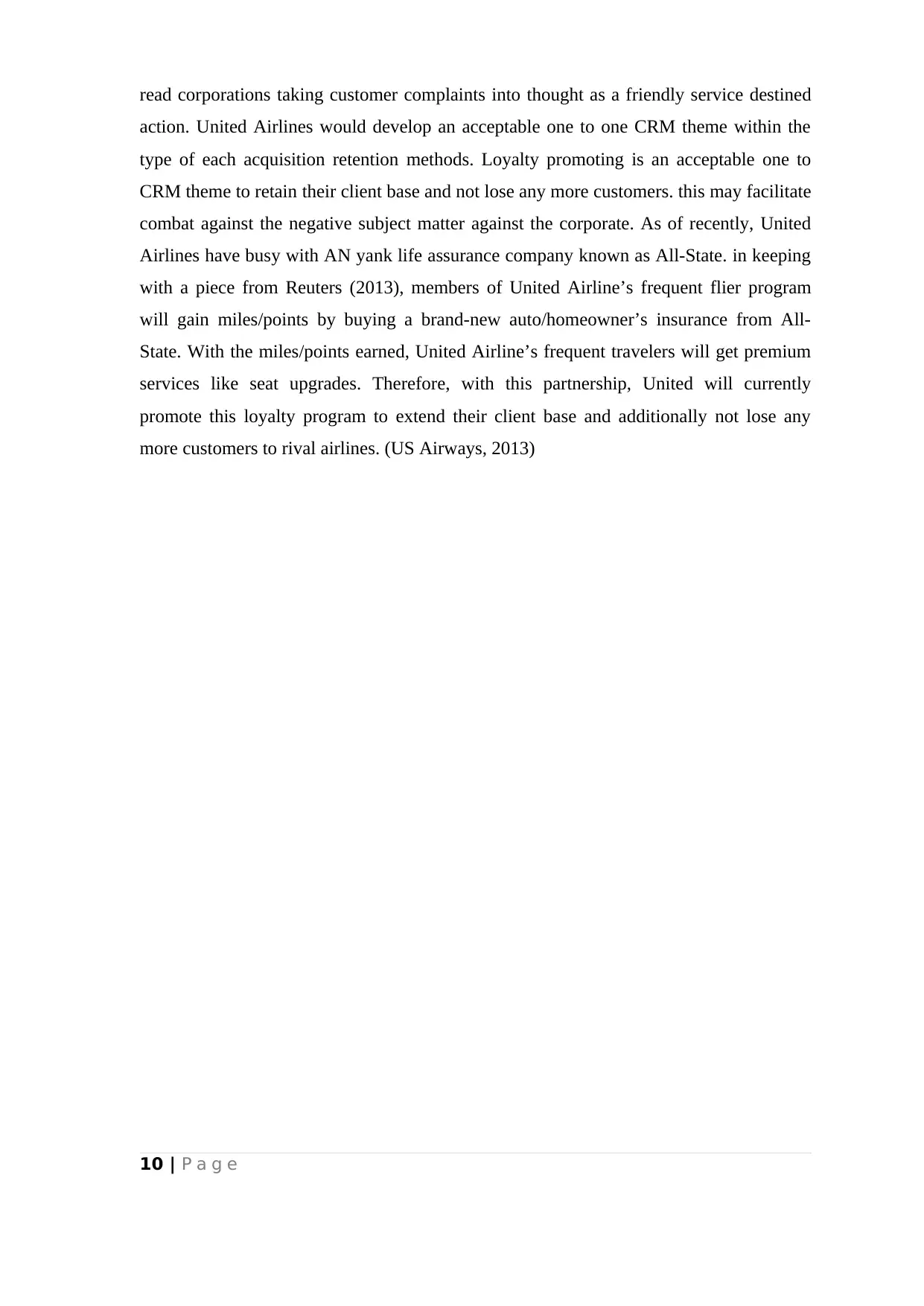
read corporations taking customer complaints into thought as a friendly service destined
action. United Airlines would develop an acceptable one to one CRM theme within the
type of each acquisition retention methods. Loyalty promoting is an acceptable one to
CRM theme to retain their client base and not lose any more customers. this may facilitate
combat against the negative subject matter against the corporate. As of recently, United
Airlines have busy with AN yank life assurance company known as All-State. in keeping
with a piece from Reuters (2013), members of United Airline’s frequent flier program
will gain miles/points by buying a brand-new auto/homeowner’s insurance from All-
State. With the miles/points earned, United Airline’s frequent travelers will get premium
services like seat upgrades. Therefore, with this partnership, United will currently
promote this loyalty program to extend their client base and additionally not lose any
more customers to rival airlines. (US Airways, 2013)
10 | P a g e
action. United Airlines would develop an acceptable one to one CRM theme within the
type of each acquisition retention methods. Loyalty promoting is an acceptable one to
CRM theme to retain their client base and not lose any more customers. this may facilitate
combat against the negative subject matter against the corporate. As of recently, United
Airlines have busy with AN yank life assurance company known as All-State. in keeping
with a piece from Reuters (2013), members of United Airline’s frequent flier program
will gain miles/points by buying a brand-new auto/homeowner’s insurance from All-
State. With the miles/points earned, United Airline’s frequent travelers will get premium
services like seat upgrades. Therefore, with this partnership, United will currently
promote this loyalty program to extend their client base and additionally not lose any
more customers to rival airlines. (US Airways, 2013)
10 | P a g e
Paraphrase This Document
Need a fresh take? Get an instant paraphrase of this document with our AI Paraphraser
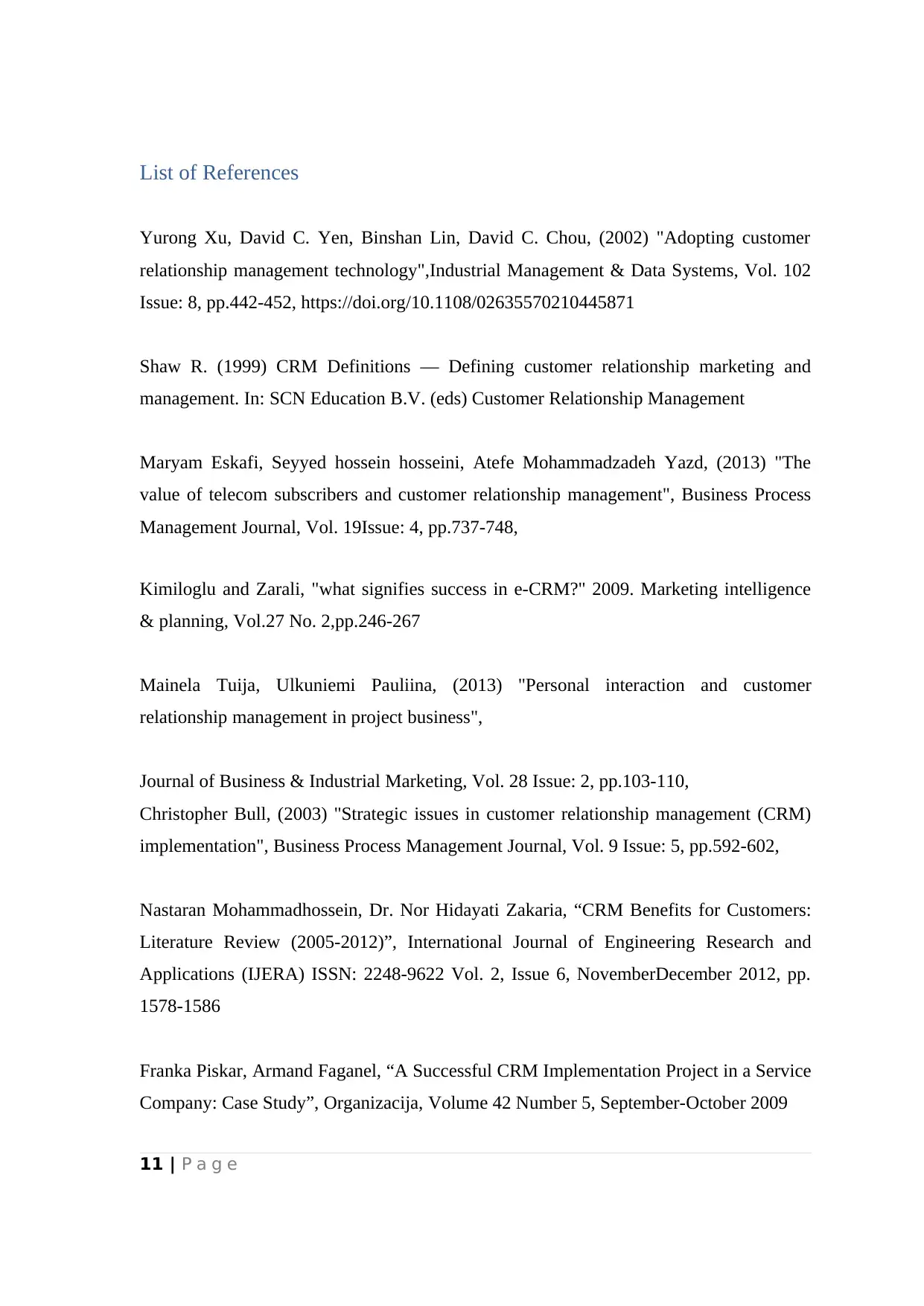
List of References
Yurong Xu, David C. Yen, Binshan Lin, David C. Chou, (2002) "Adopting customer
relationship management technology",Industrial Management & Data Systems, Vol. 102
Issue: 8, pp.442-452, https://doi.org/10.1108/02635570210445871
Shaw R. (1999) CRM Definitions — Defining customer relationship marketing and
management. In: SCN Education B.V. (eds) Customer Relationship Management
Maryam Eskafi, Seyyed hossein hosseini, Atefe Mohammadzadeh Yazd, (2013) "The
value of telecom subscribers and customer relationship management", Business Process
Management Journal, Vol. 19Issue: 4, pp.737-748,
Kimiloglu and Zarali, "what signifies success in e-CRM?" 2009. Marketing intelligence
& planning, Vol.27 No. 2,pp.246-267
Mainela Tuija, Ulkuniemi Pauliina, (2013) "Personal interaction and customer
relationship management in project business",
Journal of Business & Industrial Marketing, Vol. 28 Issue: 2, pp.103-110,
Christopher Bull, (2003) "Strategic issues in customer relationship management (CRM)
implementation", Business Process Management Journal, Vol. 9 Issue: 5, pp.592-602,
Nastaran Mohammadhossein, Dr. Nor Hidayati Zakaria, “CRM Benefits for Customers:
Literature Review (2005-2012)”, International Journal of Engineering Research and
Applications (IJERA) ISSN: 2248-9622 Vol. 2, Issue 6, NovemberDecember 2012, pp.
1578-1586
Franka Piskar, Armand Faganel, “A Successful CRM Implementation Project in a Service
Company: Case Study”, Organizacija, Volume 42 Number 5, September-October 2009
11 | P a g e
Yurong Xu, David C. Yen, Binshan Lin, David C. Chou, (2002) "Adopting customer
relationship management technology",Industrial Management & Data Systems, Vol. 102
Issue: 8, pp.442-452, https://doi.org/10.1108/02635570210445871
Shaw R. (1999) CRM Definitions — Defining customer relationship marketing and
management. In: SCN Education B.V. (eds) Customer Relationship Management
Maryam Eskafi, Seyyed hossein hosseini, Atefe Mohammadzadeh Yazd, (2013) "The
value of telecom subscribers and customer relationship management", Business Process
Management Journal, Vol. 19Issue: 4, pp.737-748,
Kimiloglu and Zarali, "what signifies success in e-CRM?" 2009. Marketing intelligence
& planning, Vol.27 No. 2,pp.246-267
Mainela Tuija, Ulkuniemi Pauliina, (2013) "Personal interaction and customer
relationship management in project business",
Journal of Business & Industrial Marketing, Vol. 28 Issue: 2, pp.103-110,
Christopher Bull, (2003) "Strategic issues in customer relationship management (CRM)
implementation", Business Process Management Journal, Vol. 9 Issue: 5, pp.592-602,
Nastaran Mohammadhossein, Dr. Nor Hidayati Zakaria, “CRM Benefits for Customers:
Literature Review (2005-2012)”, International Journal of Engineering Research and
Applications (IJERA) ISSN: 2248-9622 Vol. 2, Issue 6, NovemberDecember 2012, pp.
1578-1586
Franka Piskar, Armand Faganel, “A Successful CRM Implementation Project in a Service
Company: Case Study”, Organizacija, Volume 42 Number 5, September-October 2009
11 | P a g e
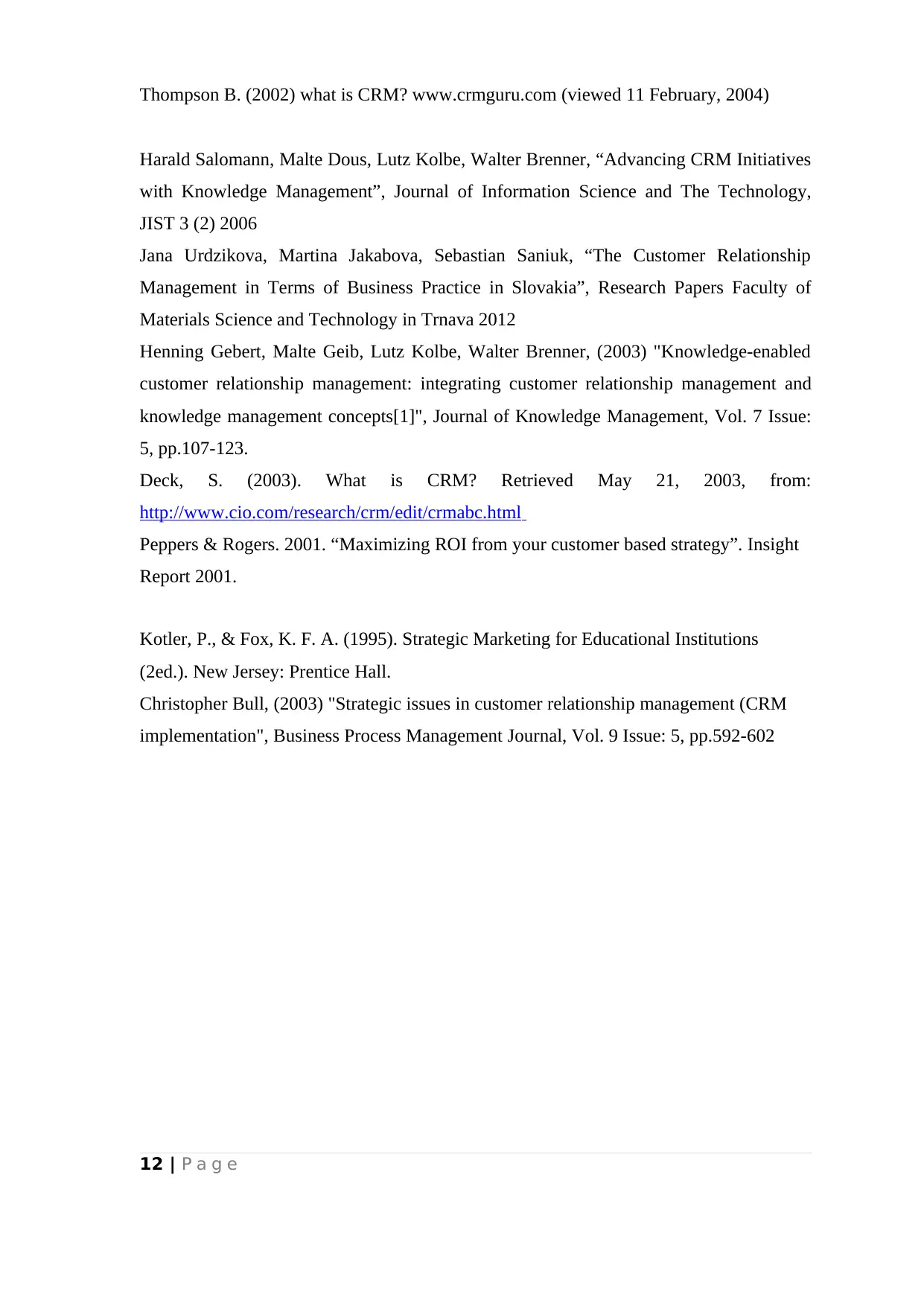
Thompson B. (2002) what is CRM? www.crmguru.com (viewed 11 February, 2004)
Harald Salomann, Malte Dous, Lutz Kolbe, Walter Brenner, “Advancing CRM Initiatives
with Knowledge Management”, Journal of Information Science and The Technology,
JIST 3 (2) 2006
Jana Urdzikova, Martina Jakabova, Sebastian Saniuk, “The Customer Relationship
Management in Terms of Business Practice in Slovakia”, Research Papers Faculty of
Materials Science and Technology in Trnava 2012
Henning Gebert, Malte Geib, Lutz Kolbe, Walter Brenner, (2003) "Knowledge‐enabled
customer relationship management: integrating customer relationship management and
knowledge management concepts[1]", Journal of Knowledge Management, Vol. 7 Issue:
5, pp.107-123.
Deck, S. (2003). What is CRM? Retrieved May 21, 2003, from:
http://www.cio.com/research/crm/edit/crmabc.html
Peppers & Rogers. 2001. “Maximizing ROI from your customer based strategy”. Insight
Report 2001.
Kotler, P., & Fox, K. F. A. (1995). Strategic Marketing for Educational Institutions
(2ed.). New Jersey: Prentice Hall.
Christopher Bull, (2003) "Strategic issues in customer relationship management (CRM
implementation", Business Process Management Journal, Vol. 9 Issue: 5, pp.592-602
12 | P a g e
Harald Salomann, Malte Dous, Lutz Kolbe, Walter Brenner, “Advancing CRM Initiatives
with Knowledge Management”, Journal of Information Science and The Technology,
JIST 3 (2) 2006
Jana Urdzikova, Martina Jakabova, Sebastian Saniuk, “The Customer Relationship
Management in Terms of Business Practice in Slovakia”, Research Papers Faculty of
Materials Science and Technology in Trnava 2012
Henning Gebert, Malte Geib, Lutz Kolbe, Walter Brenner, (2003) "Knowledge‐enabled
customer relationship management: integrating customer relationship management and
knowledge management concepts[1]", Journal of Knowledge Management, Vol. 7 Issue:
5, pp.107-123.
Deck, S. (2003). What is CRM? Retrieved May 21, 2003, from:
http://www.cio.com/research/crm/edit/crmabc.html
Peppers & Rogers. 2001. “Maximizing ROI from your customer based strategy”. Insight
Report 2001.
Kotler, P., & Fox, K. F. A. (1995). Strategic Marketing for Educational Institutions
(2ed.). New Jersey: Prentice Hall.
Christopher Bull, (2003) "Strategic issues in customer relationship management (CRM
implementation", Business Process Management Journal, Vol. 9 Issue: 5, pp.592-602
12 | P a g e
⊘ This is a preview!⊘
Do you want full access?
Subscribe today to unlock all pages.

Trusted by 1+ million students worldwide
1 out of 12
Related Documents
Your All-in-One AI-Powered Toolkit for Academic Success.
+13062052269
info@desklib.com
Available 24*7 on WhatsApp / Email
![[object Object]](/_next/static/media/star-bottom.7253800d.svg)
Unlock your academic potential
Copyright © 2020–2025 A2Z Services. All Rights Reserved. Developed and managed by ZUCOL.




